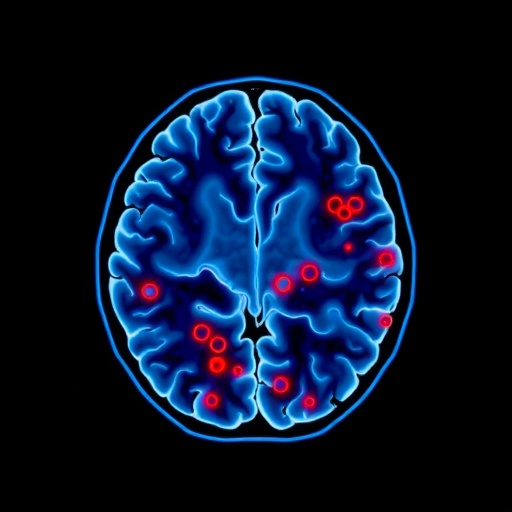In a groundbreaking study published in the journal Journal of Translational Medicine, researchers Liu, Cheng, Ma, and colleagues delve into the exciting synergy between advanced MRI techniques and stem cell therapy in the battle against ischemic stroke. As ischemic stroke remains a leading cause of disability and mortality worldwide, the exploration of innovative therapeutic approaches to regenerate damaged neuronal tissue is of paramount importance. This comprehensive research not only sheds light on current clinical trials but also presents future perspectives that could revolutionize patient care in neurology.
The study begins by highlighting the crucial role of stem cells in regenerative medicine, particularly their capability to differentiate into various cell types and secrete neuroprotective factors. This therapeutic potential resonates particularly in cases of ischemic stroke, where timely regeneration of neural tissue is essential for functional recovery. By harnessing the regenerative properties of stem cells, there is a possibility of not just halting the progression of neuronal damage but effectively promoting repair mechanisms within the brain.
Advanced MRI techniques have emerged as essential tools in both research and clinical settings, providing unparalleled insights into brain structure and function. The ability to visualize the brain’s response to injury and the subsequent effects of stem cell interventions represents a significant advancement in stroke treatment and rehabilitation. The researchers elaborate on various MRI modalities, such as diffusion-weighted imaging (DWI) and functional MRI (fMRI), which offer detailed images of brain activity and connectivity, allowing clinicians to monitor changes in real time as therapeutic strategies unfold.
In examining the interplay between stem cell therapy and advanced imaging methods, the authors lay the groundwork for a multi-faceted investigative approach to ischemic stroke management. The integration of these technologies facilitates a deeper understanding of how stem cells engraft, migrate, and contribute to neurovascular repair processes. This comprehensive analysis of both preclinical models and early-phase clinical trials provides crucial evidence of the potential efficacy of stem cell therapies when coupled with sophisticated imaging techniques.
Current clinical trials are demonstrating promising results, showcasing the safety and feasibility of stem cell administration for patients experiencing ischemic stroke. The researchers note that early-phase studies have indicated an improved functional outcome in stroke patients following stem cell treatment. Both parenteral and local delivery methods have been employed, with ongoing investigations focused on optimizing these delivery routes to enhance cell survival and integration within the ischemic environment.
The potential for advanced MRI techniques extends beyond mere visualization; they allow for the assessment of therapeutic efficacy, providing a quantitative analysis of functional improvements in brain regions affected by ischemic events. As researchers gather data on neural recovery post-stem cell treatment, advanced imaging could serve as a biomarker for predicting long-term outcomes and tailoring patient-specific treatment strategies.
Despite the optimistic findings, the research team emphasizes the need for robust protocols and standardized methodologies in future trials. For stem cell therapy to be effectively integrated into clinical practice, a comprehensive understanding of the timing, dosage, and type of stem cells used is essential. The dose-dependent effects coupled with careful monitoring of adverse events will dictate the trajectory of stem cell therapies for ischemic stroke moving forward.
In addressing the ethical considerations surrounding stem cell research, the study advocates for transparent and stringent guidelines that govern clinical applications. The generation of pluripotent stem cells, derived from both embryonic and adult sources, entails important ethical debates surrounding consent and potential moral implications. Researchers must navigate these complex issues while ensuring that scientific and clinical progress is paramount.
The collaboration between neurologists, imaging specialists, and stem cell biologists is underscored as a necessity for advancing the field. Working cohesively, these experts can bridge the gap between laboratory findings and clinical applications, ensuring that breakthroughs in stem cell therapy translate into meaningful clinical practice. The potential for interdisciplinary collaboration is not only an exciting avenue for research but also a crucial element in developing effective treatment modalities for ischemic stroke.
Moreover, the dissemination of knowledge and the sharing of best practices across international research communities are imperative. By fostering global collaborations and initiatives, researchers can expedite the translational process, ultimately benefiting patients worldwide. The promising landscape presented within this study creates a sense of urgency—stimulating not just scientific inquiry but community engagement and advocacy for innovative stroke treatments.
As the clinical landscape evolves, the implications of this research extend beyond immediate patient care. The potential to reshape the future of neurology and stroke rehabilitation rests on the identification of effective therapies empowered by advanced imaging techniques. Understanding the brain’s response to injury and recovery opens the door to new therapeutic avenues that may offer hope to millions affected by stroke.
These themes culminate in the researchers’ call for ongoing investment and funding in both stem cell research and imaging technologies. Adequate resources will be necessary to propel scientific exploration while also ensuring that findings are swiftly translated into clinical protocols, thus improving long-term outcomes for ischemic stroke patients.
In conclusion, the work of Liu and colleagues illuminates an exciting frontier in the ongoing quest to restore function following ischemic stroke. With the integration of stem cell therapy and advanced MRI techniques, the potential for enhanced patient outcomes becomes increasingly tangible. As advancements continue, the collaboration of various scientific domains will be essential to unlock the full potential of these innovative approaches, positioning the medical community on the brink of transformative progress in stroke treatment.
Subject of Research: Stem Cell Therapy for Ischemic Stroke
Article Title: Clinical trials and advanced MRI techniques with stem cell therapy for ischemic stroke: present and future perspectives
Article References:
Liu, J., Cheng, L., Ma, C. et al. Clinical trials and advanced MRI techniques with stem cell therapy for ischemic stroke: present and future perspectives.
J Transl Med 23, 1069 (2025). https://doi.org/10.1186/s12967-025-07054-5
Image Credits: AI Generated
DOI: 10.1186/s12967-025-07054-5
Keywords: Stem Cell Therapy, Ischemic Stroke, MRI Techniques, Regenerative Medicine, Clinical Trials




